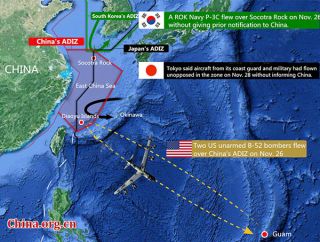Air Defense Identification Zone
The Air Defense Identification Zone (防空识别区) is a zone that can extend in some cases up to 300 miles beyond the territorial sea. It’s established by some countries off their coasts for security reasons. When entering the zone, all aircraft are required to identify themselves, report flight plans, and inform ground control of their exact position.
The zone is an early-warning air defense concept. More than 20 countries, including the United States, Canada, Australia, South Korea and Japan, have demarcated Air Defense Identification Zones on high seas or international waters since the 1950s.
After Japan's surrender in 1945, the US demarcated an identification zone off Japan's coasts, but it was under the control of the US military in Japan. It was only until 1969 that the US transferred the management of the zone to Japan.
After that, Japan expanded the zone westward twice, once in 1972, the other in 2010. Japan follows a warning sequence for unidentified aircraft: radar detection, emergency calls, fighter emergency launch, requiring forced landing, and bomb warning. Once its own aircraft, land, or vessels are attacked, a defense war will be launched. However, territorial disputes still exist, as the zone is not recognised by Japan’s neighbors, Russia and China.
China has established its first air defense identification zone over the East China Sea in accordance with Chinese law and international practices to safeguard its sovereignty, the Ministry of National Defense announced on November 23, 2013.
The East China Sea Air Defense Identification Zone includes the airspace within the area enclosed by China's outer limit of the territorial sea and the following six points: 33º11'N (North Latitude) and 121º47'E (East Longitude), 33º11'N and 125º00'E, 31º00'N and 128º20'E, 25º38'N and 125º00'E, 24º45'N and 123º00'E, 26º44'N and 120º58'E.
The People's Liberation Army (PLA) Air Force conducted its first air patrol after the establishment of the East China Sea Air Defense Identification Zone. Reconnaissance and early-warning aircraft and warplanes were deployed.
Announcement of the Aircraft Identification Rules for the East China Sea Air Defense Identification Zone of the People's Republic of China
(Issued by the Ministry of National Defense on November 23)
The Ministry of National Defense of the People's Republic of China, in accordance with the Statement by the Government of the People's Republic of China on Establishing the East China Sea Air Defense Identification Zone, now announces the Aircraft Identification Rules for the East China Sea Air Defense Identification Zone as follows:
First, aircraft flying in the East China Sea Air Defense Identification Zone must abide by these rules.
Second, aircraft flying in the East China Sea Air Defense Identification Zone must provide the following means of identification:
1. Flight plan identification. Aircraft flying in the East China Sea Air Defense Identification Zone should report the flight plans to the Ministry of Foreign Affairs of the People's Republic of China or the Civil Aviation Administration of China.
2. Radio identification. Aircraft flying in the East China Sea Air Defense Identification Zone must maintain the two-way radio communications, and respond in a timely and accurate manner to the identification inquiries from the administrative organ of the East China Sea Air Defense Identification Zone or the unit authorized by the organ.
3. Transponder identification. Aircraft flying in the East China Sea Air Defense Identification Zone, if equipped with the secondary radar transponder, should keep the transponder working throughout the entire course.
4. Logo identification. Aircraft flying in the East China Sea Air Defense Identification Zone must clearly mark their nationalities and the logo of their registration identification in accordance with related international treaties.
Third, aircraft flying in the East China Sea Air Defense Identification Zone should follow the instructions of the administrative organ of the East China Sea Air Defense Identification Zone or the unit authorized by the organ. China's armed forces will adopt defensive emergency measures to respond to aircraft that do not cooperate in the identification or refuse to follow the instructions.
Fourth, the Ministry of National Defense of the People's Republic of China is the administrative organ of the East China Sea Air Defense Identification Zone.
Fifth, the Ministry of National Defense of the People's Republic of China is responsible for the explanation of these rules.
Sixth, these rules will come into force at 10 a.m. November 23, 2013.
